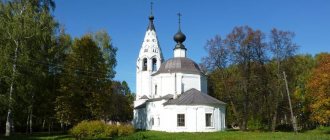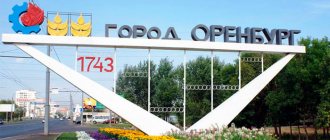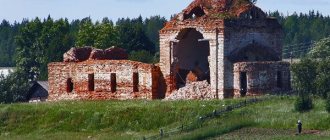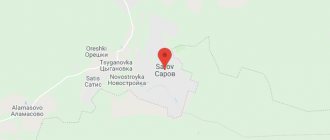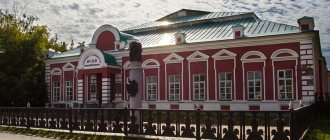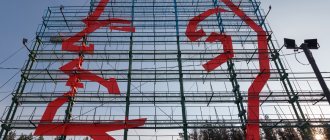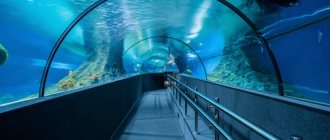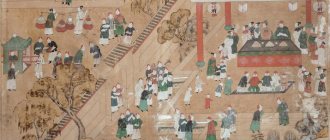Ukhta is the second most populous city in the Komi Republic, located in its central part, at the confluence of the Chibyu and Ukhta rivers. It is famous for the fact that it was in its vicinity that the very first oil production in Russian history began. Framed by the spurs of Timan, the city of Ukhta is quite beautiful, especially the old city - built in the early 1950s. in the style of the Stalin era. Mira Street and the adjacent blocks delight with architectural unity, warmth, and competent landscaping and landscaping.
The beginning of the city's history
The area around the Ukhta River, where the city will be in the future, began to be developed by people mainly thanks to oil. The settlement itself would then be named after her. This small river is a tributary of the Izhma, which in turn flows into the Pechora. It carries its waters north, to the ocean. Here, where the Ukhta (river) is located, they began to extract oil for the first time in Russia. This currently valuable mineral was found back in the 15th century, but they didn’t know how to use it then. Oil was used only for medical purposes and for lubricating mechanisms.
Oil production
Oil exploration was first organized in 1745 by the ore explorer Pryadunov. We can say that the city of Ukhta is where oil is produced in Komi today. But it was not always so. At first it was drawn from wells and springs. The distillation was carried out in Moscow, 3.6 tons of “flammable water” were brought to the laboratory. Not much by modern standards, but this is just the beginning. Even then, this oil was appreciated; it was studied in Hamburg and recognized as “no worse than Italian.” Oil was extracted very slowly by dredging from the surface of the water and from coastal pits.
For this purpose, specially on the river, at the place where the oil spring is located, a wooden frame was erected and a cutwater was made (a stone dam to fence off the frame from the river). A special container with a hole at the bottom was placed inside it; oil flowed through it on its own, rising to the surface of the water. From there they scooped it up with birch bark ladles.
At the moment, this technology seems ineffective, but at that time there was no alternative. Soon misfortunes began: first, during a river flood, the production well was destroyed, then Pryadunov was sent to prison due to non-payment of tithes. Ukhta oil was remembered only in 1868, and production resumed thanks to the merchant Sidorov. He allocated funds for drilling a well.
Then this was not the only production area; there were already wells in Galicia and Baku. Under Sidorov's leadership, about 33 tons of oil were produced. Local black gold was examined by Mendeleev himself and highly appreciated its qualities.
First settlement
For the first time, the village of Chibyu appeared on the site where the city of Ukhta is located, which happened after the revolution, in 1929. This was the first full-fledged settlement. Since 1933, Chibyu became the center of Ukhtpechlag (one of the centers of the Gulag). An unfavorable and difficult time for people, but it gave development to the village. In addition, thanks to its location in the very center of the Komi Republic, Chibyu grew and developed. Soon a new name appeared - Ukhta. At one time they even wanted to make this urban-type settlement the administrative center of the region, but all plans were confused by the war. At the same time, Ukhta received city status.
Development of lands near the Ukhta River
On the map of the Arkhangelsk province in 1846, the river already bears the name Ukhta. And now in Wikipedia in more detail: Ukhta is a river in the Komi Republic, a left tributary of the Izhma River. Length 199 km. The Ukhta is formed from the confluence of the rivers Voyvozh (length 29 km) and Lunvozh (length 29 km), which originate from the eastern spurs of the Timan at an altitude of 240 and 210 m. The main tributaries of the Ukhta: Loim (27 km), Chut (48 km) - left , Tobys (106 km) - right.
Due to the harsh climate and the lack of year-round communications, the area adjacent to the banks of the river remained sparsely populated and completely undeveloped for a long time, although oil discoveries here were known back in the 15th century. Travelers described how people living along the banks of the Ukhta River collected oil from the surface of the river and used it for medicinal purposes and as oils and lubricants. Oil collected from the Ukhta River was first brought to Moscow in 1597. Oil extraction was carried out by ore prospector G. I. Cherepanov, Arkhangelsk businessman F. S. Pryadunov and merchant M. K. Sidorov.
But let’s not delve deeply into the history of the development of Ukhta’s oil wealth, especially since we are talking about a river. The few expeditions of travelers and entrepreneurs who came to Ukhta were most interested in its subsoil, and few wrote about the river. Alexander Anatolyevich Tolubeev did this best in his book “The Ukhta River, oil fields in its area, communication routes and population.” This is how he describes the Ukhta River after visiting it in 1910:
It is written, of course, a little dryly, as befits a report, but it is informative.
And another excerpt from Tolubeev’s book:
During the years of Soviet power, during the development of Ukhta, the forest along the banks of the river was intensively cut down. The village of Chibyu, and then the city of Ukhta, was built and was almost entirely made of wood. The timber was also sent to other regions of the country. Lots of forest. Its preparation was carried out mainly in winter. The wood was put into rollers for mole rafting.
In the spring, after the ice melted, the forest was rafted. In Ukhta, on the right bank of the river, just opposite the railway technical school, a sawmill was built. The river in this place was blocked with booms, a fire was set up, and the accumulated timber was manually dragged with hooks to the shore for a log haul and further for drying and sawing.
This scheme functioned until the end of the 60s of the last century. Today along the river you will no longer find that forest, much less larch. Everything was cut down completely, and no one thought about reforestation then. Tolubeev, like many other travelers, noted that the water in the Ukhta River is clean and transparent and suitable for drinking, which cannot be said about the current state of the river. And the river was also rich in fish. Grayling, whitefish, ide, whitefish, roach, perch, pike, burbot and, of course, salmon, which went to spawn every year at the end of August, beginning of September. The young hatched from the eggs spent another 2-3 years gaining strength in the river and preparing for a long voyage to the northern seas. Once, in the late 80s, I got into a conversation with an inspector from Rybnadzor, who told me information that was unexpected for me. It turns out that there was a so-called Vodno salmon herd of up to 4 thousand heads. The Ukhta River still belongs to the salmon spawning category. Only this is where that salmon is today, and there is a noticeable decrease in other fish in the river. Mole rafting, when the river bottom from the upper reaches to the city was strewn with driftwood, and rotting wood poisoned the water, discharges from the oil refinery and the city itself did not contribute in any way to the preservation of the river ichthyofauna.
Chibyu River and the birth of the city
Speaking about the Ukhta River, one cannot help but talk about one of its tributaries - the Chibyu River. The history of the city began with it, when on August 21, 1929, the Ukhta expedition of the OGPU landed in the place where Chibyu flows into the Ukhta River and the construction of a village began, called Chibyu. Until the 60s of the last century, the river was really fast, high-water and clean; in some places the depth reached three meters. Forests grew on both banks, red and black currants grew in the lowlands, and fish were found. The trees did not allow it to dry out. But the city was being built and advancing on Chibyu. In the first half of the 70s, from the village of Zabolotny, all the way to the Ukhta River, a canal was dug - a new artificial channel of the Chibyu River. The canal was built almost three meters lower than the old riverbed, and the difference in height is visible in the area of the bridge to Shudayag.
The site for construction was, of course, freed up, the groundwater level in a vast area was significantly lowered, but the city lost a beautiful river, beaches and forest. The deadliest blow to Chibyushka came in 1975. Old Ukhta residents, of course, remember that on Zabolotny, where there is now a memorial sign to the victims of political repression, there was a zone. And across the road, on the site of the Lukoilov gas station, there are two large camp pigsties. When the pigsties were demolished, all the manure from the manure storage facility was simply shoveled into the river, killing all the fish. Unfortunately, today Chibyu is more like a large drainage ditch; in some places the river does not freeze in winter, as warm water flows from the sewage outlets. City residents also contribute by littering the banks and riverbed with garbage. I would like to note that Chibyushka was not left to the mercy of fate. Thanks to the efforts of Gazprom Transgaz Ukhta LLC, the river bank in the area of Gazovikov embankment has been remarkably landscaped, and from the city the river received a new bridge in the KiO park and landscaping of the pond.
A little more about the Ukhta River
But let's return to the Ukhta River. Despite its small width and smooth flow, the river periodically presented the city with surprises, especially during the spring flood.
In the 40-60s of the last century, the Workers' Village, Zarechnaya, Pochtovaya, Vokzalnaya, Yuzhnaya streets and the floodplain of the river where the Dynamo stadium was located, always found themselves in the flood zone. For example, on May 19, 1946, a water rise of 252 cm was recorded.
In 1962, the new Neftyanik Sports Palace opened its doors in Ukhta. They built it in the floodplain of the Ukhta River on the site of the old stadium, and it also suffered from high water.
The very next year, a dam was filled with rubble along the river, protecting it and the stadium from flooding.
Well, the largest rise in water on the river was in 1992 - 678 centimeters. That, for now, seems to be all I wanted to tell you about the Ukhta River. The story may not be very complete, but don’t judge too harshly.
Museum of Gazprom-transgaz Ukhta LLC
This complex of exhibition halls, which began in 2003, is dedicated to the history of the development of the gas industry in the Russian North. Their total area exceeds 1500 square meters.
Museum of Gazprom-transgaz Ukhta LLC
This exhibition space features 19 permanent exhibitions operating on two exhibition grounds. The exhibitions are designed using the most modern technologies. They very clearly tell about the long history of the industry. An interesting object of the exhibition is the diorama “Shine of the North”, depicting the moment of welding the first joint of pipes on the 1st Ukhta gas pipeline with the same name as the diorama.
There are excursions adapted for children - in particular, the quest game “Travel with Northern Gas”.
Moreover, here every visitor has the opportunity to take an imaginary flight in a Mi-8 helicopter over the gas pipeline route.
Address: Lenina Ave., 50. Since August 2022, a second exhibition has also been open, at the address: emb. Gazovikov, 10/1.
Camp times
The infamous Ukhtpechlag is associated with Ukhta. The Ukhta-Pechora camp included a huge territory of 1.5 million km2 with its center in Ukhta. What a vast area, and yet everything is dedicated to prison! It also included the upper and middle reaches of the Vychegda and the Pechora basin. The camps also captured the Timan Ridge. If you look on old maps of Russia to find out what region Ukhta is in, then on them it was listed as the Autonomous Region of Komi. Today it is not part of the region, but of another subject of the Federation - the Komi Republic.
The Ukhtpechlag administration was located in Chibyu (present-day Ukhta). Since 1931 it has been one of the Gulag prison centers. More and more prisoners were brought here along the highway.
The barracks were overcrowded; according to data, there were about two thousand people here. In 1929, a mechanical repair plant opened here. It was thanks to the repressed that the village began its intensive development, and the development of the north took place. The prisoners had a lot of hard and life-threatening work; not everyone lived to see their release. They mined coal, obtained radium from local radioactive waters in laboratories, and significantly increased the volume of oil produced. The world's only oil mine was built in the upper reaches of the Yarega River, where they began to extract heavy oil. A vocational school was even organized, where the necessary specialists were trained from prisoners.
Finance
The Murmansk region is located in the north-west of the European part of Russia and is objectively one of the strategic regions of the country within the North-Western Federal District.
The Komi Republic borders on the Tyumen region, namely on its constituent Yamalo-Nenets Autonomous Okrug in the east and northeast, the Khanty-Mansiysk Autonomous Okrug in the south and southeast, the Sverdlovsk region in the south, the Perm Territory in the south, and the Kirov region in the south, west and southwest, the Arkhangelsk region, including the Nenets Autonomous Okrug in the north, northwest and northeast.
He struck the man several times with his hands and feet on the body, from which the victim died at the scene.
Kashketi executions
In 1936, protests began among political prisoners. They demanded their separate maintenance from criminals, improved living conditions and normal medical care. In 1937, 6,890 prisoners were already serving their sentences in the camp.
Since 1938, mass executions began under the leadership of Lieutenant Kashketin. At that time, 86 prisoners were executed in the village of Chibyu. And in the area of the Ukhtarka River, 1,779 people were shot in a short time. In order to destroy such a number of people in a short time, they resorted to a trick. They organized a “transition” from one camp to another, lined up the prisoners in a column and led them through the tundra, where an ambush and a prepared grave awaited them. All prisoners were shot with a machine gun. These events would later be called the “Kashketi executions.” Soon after this, the village left the Gulag, and power again transferred to the Komi administration.
Architecture
A typical northern Russian city with a mining industry is Ukhta. You can see right away where the city-forming enterprises are located.
If you look at the city from an elevated position, you can see an industrial zone in one part of the view. Here is the Ukhta oil refinery, which was launched during the Gulag period (in 1934).
In another part you can see the residential buildings of the city; they, like steps, go from bottom to top. This is due to the fact that the city was built on the Timan Ridge. The buildings are dominated by high-rise buildings from the 60s to 80s. The massive Oil and Gas Research Institute is also visible. There is also the old town, the embankment of the Ukhta River, the victory memorial and the Lukoil office.
Mount Vetlosyan with a huge profile of Lenin at the top
A significant landmark of Ukhta is the Vetlosyan Hill, which offers a wonderful view of the entire city. The name comes from the language of the Komi people: “Vetlosyan tui” means “hunting path”. During the GULAG, there was the village of Vetlosyan, next to a woodworking plant, and there was also a first-aid post, which was initially housed simply in army-style tents.
In 1970, on the occasion of the 100th anniversary of Lenin’s birth, an original art object was placed on Mount Vetlosyan, just opposite the railway station, which became one of the main symbols of the city of Ukhta. This is a giant profile of Lenin's head 33 meters high.
Initially, the profile was illuminated at night with 120 lamps, but in the 1990s this lighting disappeared, the metal structures rusted, and the memorial sign was in danger. Only in the 2010s was it restored and the lighting was returned to it.
Mount Vetlosyan with a huge profile of Lenin at the top
It is interesting that this profile, welded from metal pipes, was an “amateur activity” of local authorities - more precisely, the first secretary of the CPSU city committee of Ukhta in 1967 -1974. Nikolai Kochurin. On a trip to the sea, he saw such an object in Batumi, on a mountain, glowing. At home, for the 100th anniversary of the leader, I decided to install the same one, but significantly larger than the Georgian one in size. Realizing that approvals were fraught with long bureaucratic red tape, he organized the installation of a memorial sign without notifying senior management.
Using metal balconies and stairs you can climb to the height of the tenth floor and explore Ukhta not just from the mountain, but also from a bird's eye view.
Old city
You can see interesting architecture in the old town. Ancient buildings were once created in the USSR according to the designs of talented architects P.K. Murzin and Zhizhimontov. One of them was a prisoner. Although they were both from Moscow, the Leningrad style can be seen in the old city.
The old town, built in the 50s, sets Ukhta apart from other cities with the oil industry. The streets are wide, the buildings are all different, but in a common style. On the houses themselves there are a lot of small and large decorative elements from the times of the USSR. It feels like a short but interesting story.
There is a local history museum, and next to it is a monument in the form of a stone, stern and gloomy, dedicated to the innocent victims of repression. There are also technical schools in the city: Mining and Railway transport. The same wooden barracks and buildings from which the village of Chibyu, which later became Ukhta, began, have been preserved.
In Ukhta you can see a memorial and chapel dedicated to the memory of those who died during the fire in the shopping center. 25 people were burned alive, mostly employees of the shopping center. According to the official version - arson, two teenagers were sentenced to life imprisonment.
The Temple of Stephen of Perm makes an interesting impression. Looking at it, it is difficult to believe in the church purpose of this building. In appearance, it is an ordinary cultural center, although very beautiful. And indeed, it used to house the oil workers' recreation center. Only in 1994 it was converted into a temple. They say that the architect Zhizhimontov, who designed this building, was a believer and always dreamed of building a temple. Thus, his dream came true, but not immediately, but after about half a century. However, dreams come true, no matter what.
Monument to the Prometheans of the North
Driving along the Syktyvkar-Ukhta highway, at the entrance to the city you can see an extraordinary monument to an oil and gas industry worker. Surrounded by pipes, he lights a torch that brings warmth to the people. This monumental sculpture is dedicated to all participants in the development of local deposits and is called “Prometheans of the North”.
Monument to the Prometheans of the North
The monument was erected in November 2003. This is a bronze monument, 4 meters high, mounted on a high granite pedestal. The author of the monument was the famous sculpture from Syktyvkar A.I. Neverov. The worker’s sculpture fits well into the surrounding area and rightfully became one of the main symbols of the city of Ukhta.
Address: Lenin Ave., 50.
National composition of the population
So, we talked about statistics regarding the number of city residents. Now it’s worth considering the population of Ukhta from the point of view of national composition. Many different nationalities live here. This diversity of nationalities is largely explained by the history of these places. According to the 2010 census data, the following people live in Ukhta: Komi (about 7.9%), Russians (about 81%), Ukrainians (about 4.1%), Tatars (about 1%), Belarusians (also about 1%) .
The indigenous population of these places are Komi. There is also another name - Komi-Zyryans. These are people of Finno-Ugric origin who have long lived on the territory of the Komi Republic and in neighboring regions.
Museum of Liquidators of Technogenic Disasters
This museum opened in Ukhta on April 26, 2013, on the 27th anniversary of the Chernobyl nuclear power plant accident, on the initiative of a local public organization of Chernobyl liquidators. Its museum doors are always open to everyone, and primarily to schoolchildren.
Here the children are told about the essence of the Chernobyl disaster and about the work of fellow countrymen who took part in eliminating its consequences. Among the exhibits of the museum are the protective suits in which the liquidators worked, various dosimeters that measured the level of radiation, children's creative works on the theme of Chernobyl, photographs from the sites of those dramatic events and photographs of the liquidators of the accident themselves.
Museum of Liquidators of Technogenic Disasters
Educational films and videos about the accident at the Chernobyl nuclear power plant and the liquidation of the consequences of other man-made disasters in the USSR and Russia are shown.
After such an excursion, children can confidently talk about the Chernobyl accident in class and correctly answer any questions regarding this event.
Address: Kosmonavtov Ave., 19.
Transport
So, we talked about the time and time zone in which Ukhta is located. Now we need to consider the transport network in the city. Transportation of passengers and various cargoes is carried out in several ways.
The first type is rail transport. The city has a station that belongs to the Northern Railway. Both passenger and cargo transportation are carried out here. This direction passes through several regions in the north of Russia, to be more precise - through Arkhangelsk, Kostroma, Vologda and other regions.
The most convenient way to get around the city is to use buses. There are many routes here that allow you to easily get to the right place. Suburban and intercity buses also run constantly. You can travel from Ukhta to Syktyvkar, Kirov, Ufa and other cities. Recently, the idea of creating special trolleybus routes here has been considered.
Memorial to fellow countrymen-participants of the Great Patriotic War
This monument to Ukhta front-line soldiers was erected in the city in 1980. Construction completed in 1984. The memorial is made in the form of a five-pointed star inscribed in a circle with a 14-meter diameter. From its rays rise 15-meter planes, symbolizing half-mast banners.
Memorial to fellow countrymen-participants of the Great Patriotic War
These planes are united by a ring, on the inner side of which a wreath is depicted, and on the outer side - five Orders of the Patriotic War. The eternal flame stands on a base made of Karelian granite. Granite steps lead to the pedestal. On the square in front of the main monument of the memorial there are eight granite pedestals with inscriptions.
Location: in the park on the bank of the Ukhta River, at the intersection of Mira and Oktyabrskaya streets.
City management
Now you need to get a little acquainted with how management is carried out in a populated area. Like any other region, the Komi Republic is divided into administrative-territorial units such as districts and districts.
Here there is the urban district of Ukhta, the center of which is the city of the same name. It is interesting that this municipal entity is equal in status to the regions of the Far North. It is located in the central part of the Komi Republic.
The administration of the territory of this municipal unit is carried out by the administration of Ukhta. The urban district was formed here in 2005. Currently, it includes 18 settlements, among which there are urban-type settlements, villages and villages. The administration of Ukhta is located at the address: Bushueva street, building 11.
Museum of 20th Century Migrants
A private museum, created by a local collector-enthusiast, head of the research club, Victor Moor. The museum was based on its collection of antiques, things and household items of the first half of the twentieth century.
This extraordinary exhibition is housed in a railway carriage built in 1902. Most of the exhibits presented in the museum came from immigrants to Ukhta from other regions of Russia - hence the name.
Museum of 20th Century Migrants
In addition to the unique feeling of traveling back in time, a visit to the Museum of 20th Century Migrants gives the visitor a deep understanding of how much human life has changed over these decades, how much easier and more comfortable it has become for everyone these days.
Address: st. Bushueva, 5b.
Economy
It is necessary to talk about such an important component of the city as the economy. In Ukhta, its basis is the oil and gas industry. Several large enterprises involved in this industry are located here. Oil production began here a very long time ago. If we turn to history, the geological study of these places dates back to 1929. Then the famous specialist N.N. Tikhonovich came here. It was decided to drill several test wells. And already in 1930, a stationary drilling rig was erected here and oil production was carried out for the first time. As already mentioned, the city of Ukhta became the first in Russia where they began to extract this fuel.
Various auxiliary objects are located around. For example, a chemical laboratory began to operate nearby, where drilling processes and much more related to this industry were studied.
To transport the extracted raw materials, it was also necessary to develop a transport network. For this purpose, it was decided to build the Ust-Vym – Ukhta highway. Its length was more than 250 kilometers. Construction of another major route also began - the railway that connected Kotlas and Vorkuta. This route passed through Ukhta. Thus, the oil produced in these places began to be transported to the large industrial centers of our country.
Monument to graduates of the Ukhta school who died in the Great Patriotic War
The monument is located in the center of the main alley of the Children's Park, on a round platform, which was formerly called “Pioneer Glory Square”. The memorial consists of bas-relief images of pioneers and soldiers of the Soviet Army, as well as battle flags bowed in grief, painted on a concrete slab. Also attached to the slab are plaques with the names of fellow countrymen who died in the war.
Monument to graduates of the Ukhta school who died in the Great Patriotic War
Location: Children's park.
Local climate
So, we discussed issues related to the economy and management of the city, as well as its population and time zones. Now it is necessary to get acquainted with the local climate and nature, since this is also an important component of any settlement. Russia can boast of a variety of natural and climatic zones. The Komi Republic, Ukhta lies in an area with rather harsh natural conditions.
The climate here is temperate continental. Typically, these places have warm but short summers; the average July temperature is about +15°C. Winter here is cool and quite long. The average January temperature is -17.3°C. Snow falls in early October, but permanent snow cover does not form until the end of the month. It usually disappears at the end of April - beginning of May. Weather phenomena such as blizzards, hail, thunderstorms and ice are often observed here.
Nature reserves "Belaya Kedva", "Sedyuksky", "Chutinsky"
A number of nature reserves have been created in the Komi Republic. In the vicinity of the city of Ukhta there are also beautiful protected areas that are local natural attractions. They carefully preserve the beauty of nature in its original form. Of great interest are the rivers and forests, the unique landscape, and rare species of flora and fauna of the local region.
In the Belaya Kedva reserve
Nature
The magnificent nature of these places also amazes with its diversity and beauty. She will truly delight and leave an unforgettable impression. The area is mainly dominated by spruce and pine forests. Other trees are often found, for example, birches and other small-leaved plants. Walking through the forest, you can periodically see various marshy areas.
Many representatives of the flora grow here, which have long been listed in the Red Book. There are more than 20 plant species that are on the verge of extinction. Among them, we can separately mention alder buckthorn, columbine basilisk, common bird cherry and others.
As for the animal world, about 35 species of different mammals live here. Most often you can see squirrel, brown bear, pine marten, moose, river otter, wild boar and other animals. Thus, the Komi Republic, Ukhta and other nearby settlements can boast of a rich fauna.
Birds are mainly represented by the passerine order, of which there are more than 55 species in these places.
In the surrounding area there are many natural monuments: the rocks of the Timan Ridge, the Belaya Kedva and Chutinsky nature reserves, Paraskin Lakes, mineral springs and others.
Environmental monitoring and protection
Regular observations of the chemical composition of atmospheric precipitation in Ukhta began in June 1992.
The acidity of precipitation, measured in total monthly average samples, in 1992 in Ukhta was 6.5 (the norm is 5.7).
The average annual value of sediment mineralization in Ukhta in 1993: sulfates - 20.14 mg/l; carbonates - 28.49 mg/l.
Emissions of pollutants from stationary sources in Ukhta in 1993: sulfur dioxide - 0.708; solids - 2.129; carbon monoxide - 3.734; nitrogen oxides - 5.429; hydrocarbons - 79.772; total - 110,641.
Change in average annual (top line) and maximum (bottom line) characteristics of atmospheric air pollution in Ukhta, mg/m³
| Toxicant | 1989 | 1990 | 1991 | 1992 | 1993 |
| Dust | 0,1 | 0,1 | 0,1 | 0,1 | 0,1 |
| 0,9 | 0,9 | 0,9 | 0,7 | 0,6 | |
| Sulphur dioxide | 0,01 | 0,004 | 0,003 | 0,002 | 0,001 |
| 0,06 | 0,029 | 0,034 | 0,039 | 0,030 | |
| Carbon monoxide | 1,0 | 1,0 | 2,0 | 1,0 | 1,0 |
| 17,0 | 8,0 | 9,0 | 12,0 | 12,0 | |
| Nitrogen dioxide | 0,03 | 0,02 | 0,02 | 0,01 | 0,02 |
| 0,050 | 0,15 | 0,14 | 0,37 | 0,42 | |
| Hydrogen sulfide | 0,002 | 0,001 | 0,001 | 0,001 | 0,001 |
| 0,020 | 0,010 | 0,009 | 0,013 | 0,018 | |
| Methyl mercaptan | – | 3,4*10−5 | 3,2*10−5 | 3,0*10−5 | 2,7*10−5 |
| 22,0*10−5 | 12,2*10−5 | 9,8*10−5 | 13,5*10−5 | ||
| Soluble sulfates | 0,01 | 0,00 | 0,00 | 0,00 | 0,00 |
| 0,04 | 0,00 | 0,09 | 0,01 | 0,01 | |
| Benz(a)pyrene, µg/m³*10−3 | 0,4 | 1,3 | 0,9 | 0,6 | 0,5 |
| 0,9 | 2,9 | 1,8 | 1,1 | 1,7 |
Vegetation
The vegetation cover is quite diverse, characterized by a predominance of spruce and pine forests.
Among the spruce forests at higher elevations, green moss forests predominate, while at lower elevations, swampy sphagnum types of spruce forests predominate.
Pine forests are predominantly lichen-green moss and green moss, and in depressions and along the edges of swamps they are swampy.
The swamps are distributed in small shallow areas throughout the area.
There are many secondary small-leaved, mainly birch, forests.
Rare and endangered plants
In alphabetical order of Russian family names [3]:
Legume family (Leguminosae)
- Cold astragalus (Astragalus frigidus(L.) A.Gray)
Family Caryophyllaceae
- Creeping gum (Silene repens Patrin) - listed in the Red Book of the Komi Republic
Family Kostenzovye, or Aspleniaceae (Aspleniaceae)
- Green husk (Asplenium virideHuds.)
- Wall bone (Asplenium ruta-murata L.)
- Steller's cryptogram (Cryptogramma stelleri(SGGmel.) Prantl)
Buckthorn family (Rhamnaceae)
- Alder buckthorn (Frangula alnus Mill.)
Ranunculaceae family
- Siberian Adonis (Adonis sibiricus Patrin ex Ledeb.), Komi Krasnoyar Turun - listed in the Red Book of the Komi Republic
- Water-leaved basilisk (Thalictrum aquilegifolium L.), Komi Zarni Turun, Komi Baba Turun - included in the Red Book of the Komi Republic
- Open lumbago, or sleeping grass (Pulsatilla patens(L.) Mill.) - included in the Red Book of the Komi Republic
| The shot is open. General view of a flowering plant. Neighborhoods of Ukhta. |
| The muzzle is leafless. Flowering plant. Neighborhoods of Ukhta. |
| Peony evasive. Escape with a bud. Neighborhoods of Ukhta. | Spotted palmate root. Leaves. Neighborhoods of Ukhta. |
Family Onocleaceae
- Common ostrich (Mattheuccia strutiopteris(L.) Tod.)
Orchid family (Orchidaceae) (all plants are subject to protection)
- The real slipper (Cypripedium calceolus L.) is listed in the International Red Book and the Red Book of Russia
- Dark red nappet (Epipactis atrorubens(Hoffm.) Schult.)
- Tuberous calypso (Calypso bulbosa(L.) Oakes) - listed in the Red Book of Russia
- Gymnadenia conopsea (L.) R.Br. )
- Leucorchis albida(L.) E.Mey.
- Lyubka bifolia (Platanthera bifolia(L.) Rich.)
- Leafless mullet (Epipogium aphyllum(FWSchmidt) Sw.) - listed in the Red Book of Russia
- Spotted fingerroot (Dactylorhiza maculata(L.) Soó)
- Orchis latifolia L.
Sedge family (Cyperaceae)
- White sedge (Carex alba Scop.)
Family Primulaceae
- Cortusa matthioli L.
Peony family (Paeoniaceae)
- Peony evasive, or marin root (Paeonia anomala L.)
Family Bladderworts (Lentibulariaceae)
- Alpine butterfly (Pinguicula alpina L.)
Family Rosaceae
- Cotoneaster melanocarpus Fisch. ex Blytt
- Bird cherry (Padus racemosa(Lam.) Gilib.)
Family Ophioglossaceae:
- Virginian rosebush (Botrychium virginianum(L.) Sw.)
Animal world
The fauna is represented by mammals of 35 species from 6 orders and 15 families. A significant part of mammals is of practical importance, being either objects of fishing or objects of hunting for commercial predators (small mouse-like rodents). Game mammals include: squirrel, fox, brown bear, pine marten, ermine, European mink, river otter, elk, wild boar. Like game birds, these animals are only objects of amateur hunting. Brown bear, river otter, elk and wild boar, according to the hunting rules of the Komi Republic, are hunted only under special permits (licenses).
The avifauna is represented by 115 species from 12 orders and 35 families. The most numerous is the order of passeriformes, which includes up to 58 species, which is ~50% of the listed avifauna.
